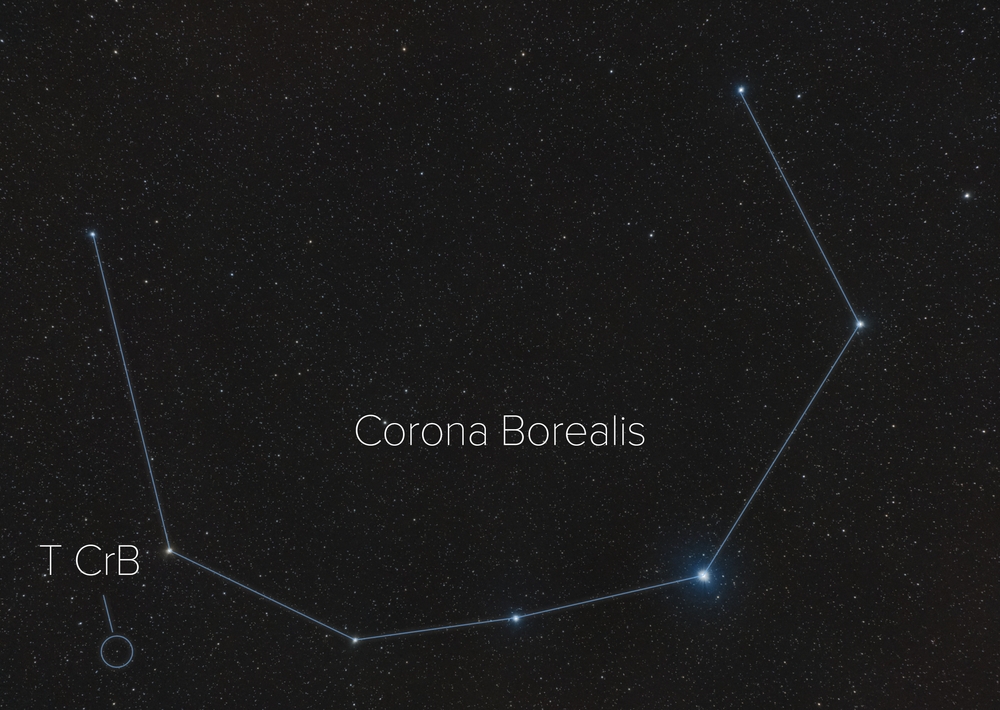The Blaze Star Will Soon Explode After 80 Years of Waiting
Posted on Categories Discover Magazine

The clock is ticking for the binary star T Coronae Borealis, as it’s only a matter of time before it explodes in a blaze of light that will be visible here on Earth. Although astronomers aren’t sure exactly when this spectacle will unfold, they say the binary star — given the fiery nickname, the Blaze Star — is likely to ignite later in 2025.
The Explosive Cycle of T CrB
T Coronae Borealis (T CrB) is a nova located about 3,000 light-years from Earth in the constellation Corona Borealis (the Northern Crown), which lies in the northern sky. It consists of two stars that orbit each other: one is a white dwarf star — the hot, dense stellar core that remains after a low- or intermediate-mass star has exhausted its fuel, nearing the end of its evolution. The other is a red giant, a previous stage of stellar evolution in which a dying star with an expanding radius and diminishing surface temperature runs out of hydrogen fuel.
The interaction between these two stars incites a fierce reaction that will massively increase the luminosity of the star system for a brief amount of time. As the red giant sheds its outer layers, the white dwarf will pull the hydrogen waste to its own surface. This causes a buildup of pressure and heat, and eventually the star reaches a breaking point and experiences a thermonuclear explosion.
The sight of this nova is something that most people on Earth may only get to see once in their life. This is because T CrB is a recurrent nova, meaning it goes through a cycle in which the white dwarf is fed material from its companion star, ignites, and then repeats the process over again (a nova usually does not result in the destruction of a white dwarf, unlike what happens in most supernovae).
Read More: Astronomers Will Be Ready To Study Future Supernovas In Action
Waiting 80 Years For a Nova
T CrB was first discovered in 1866 by Irish astronomer John Birmingham, although it wasn’t until the next nova in 1946 that astronomers realized it only makes an appearance every 80 years. Based on this cycle, we’re now overdue for another T CrB flareup.
Signs of an impending explosion began to appear in 2016 when the star significantly brightened, and then, in April 2024, a notable dip in brightness was announced by the American Association of Variable Star Observers.
This series of events — an approximately decade-long increase in brightness before a sudden pre-eruption dip — follows the same lead-up to the previous 1946 nova. With this in mind, scientists initially predicted that the nova would occur sometime between Late Spring and Early Fall 2024. However, the year passed and T CrB remained idle.
The truth is, novae like T CrB are somewhat unpredictable and don’t adhere to a strict schedule. The changes in brightness indicate that the nova could happen any day now, yet it’s impossible to pinpoint an exact date. Astronomers are confident, though, that it will take place in 2025, and they’ll continue to closely monitor the white dwarf near the Corona Borealis constellation for any developments.
Where Will T CrB Show Up?
From our point of view on Earth, the nova will result in a newly brightened star popping up in the night sky. However, it will only be visible for a few days before fading, so stargazers may want to be prepared for whenever T CrB decides to shine.
The star will appear in between the constellations Hercules and Boötes; another way to track it down is to draw a straight line from Arcturus to Vega, two of the brightest stars in the northern celestial hemisphere. The constellation Corona Borealis lies nearly right in the middle of this imaginary line, and T CrB will gleam right beside the constellation.
Article Sources
Our writers at Discovermagazine.com use peer-reviewed studies and high-quality sources for our articles, and our editors review for scientific accuracy and editorial standards. Review the sources used below for this article:
Jack Knudson is an assistant editor at Discover with a strong interest in environmental science and history. Before joining Discover in 2023, he studied journalism at the Scripps College of Communication at Ohio University and previously interned at Recycling Today magazine.